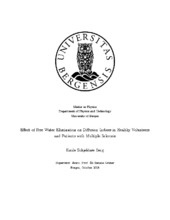| dc.contributor.author | Berg, Emile Schjeldsøe | |
| dc.date.accessioned | 2018-11-09T15:37:56Z | |
| dc.date.available | 2018-11-09T15:37:56Z | |
| dc.date.issued | 2018-11-08 | |
| dc.date.submitted | 2018-11-07T23:00:03Z | |
| dc.identifier.uri | https://hdl.handle.net/1956/18711 | |
| dc.description.abstract | Diffusion tensor imaging (DTI) is a technique in magnetic resonance imaging (MRI) that can be used to image the brain microstructure beyond the resolution that is achievable using conventional imaging. By utilizing DTI, it is possible to study the neuronal fiber bundles non-invasively, fascilitating virtual dissection of internal brain structures. One problem this technique faces, however, is the effect of free water contamination, i.e voxels inherently or due to disease processes have higher water content (isotropic diffusion) or consist of crossing fiber bundles (mixed mode contribution). In order to get a more accurate estimation of the diffusion indices, a new model was introduced by Prof. O. Pasternak. The free water elimination (FWE) model removes the free water contamination in DTI. By estimating a free water portion of the diffusion tensor, a free water corrected tensor can be estimated that has a more accurate anisotropy. This master project is an application of the FWE model on a group of healthy volunteers and on a group of participants recently diagnosed with Multiple Sclerosis (MS). FWE is applied in each participant group. Diffusion indices are then estimated and compared, both before and after FWE and between the two groups. Four regions of the brain are evaluated and compared: white matter, grey matter, the whole brain, and a small region of interest (ROI) in the corpus callosum. Using a baseline b0 image, grey and white matter masks are able to be segmented based on a probability threshold (> 80%). This allows for the estimation of the relevant indices isolated to these regions. By combining this with images of the change in the indices caused by FWE, it is possible to get an understanding of where it has the highest impact. FWE was applied to the healthy volunteers in order to get an understanding of the effects of free water correction. Furthermore, it was of interest to repeat the analysis for a patient group to see how these effects might change. In this thesis, FWE is applied to a group of participants with MS for the first time, this is done for a technical evaluation and not for clinical purposes. The effect of FWE within each group is significant for almost all regions and indices, approximately 20%. The change in eigenvalues and anisotropy indices is similar to the findings of established literature. It is the first time this technique has been applied to MS, and the results are promising for future follow-up studies using FWE. In the white matter and whole brain analysis there are non-significant differences between the two groups. However, the anisotropy measures in the grey matter are significantly higher in the healthy volunteers compared to the participants with MS. FWE has a significant impact on diffusion indices, in all regions investigated in this thesis. Because FWE is a new and still developing technique, the work in this thesis has been important to achieve a better understanding of how FWE works, and shows a lot of promise for future study and development. | en_US |
| dc.language.iso | eng | eng |
| dc.publisher | The University of Bergen | en_US |
| dc.subject | FWE | eng |
| dc.subject | MRI | eng |
| dc.subject | Free water | eng |
| dc.subject | free water elimination | eng |
| dc.subject | diffusjon | eng |
| dc.subject | Diffusion | eng |
| dc.subject | DWI | eng |
| dc.subject | MS | eng |
| dc.subject | Frivannsjustering | eng |
| dc.subject | Diffusjon | nob |
| dc.subject | Magnetresonanstomografi | nob |
| dc.subject | Medisinsk avbildning | nob |
| dc.subject | Multippel sklerose | nob |
| dc.title | Effect of Free Water Elimination on Diffusion Indices in Healthy Volunteers and Patients with Multiple Sclerosis | en_US |
| dc.title.alternative | Effect of Free Water Elimination on Diffusion Indices in Healthy Volunteers and Patients with Multiple Sclerosis | eng |
| dc.type | Master thesis | |
| dc.date.updated | 2018-11-07T23:00:03Z | |
| dc.rights.holder | Copyright the Author. All rights reserved | en_US |
| dc.description.degree | Masteroppgave i fysikk | en_US |
| dc.description.localcode | MAMN-PHYS | |
| dc.description.localcode | PHYS399 | |
| dc.subject.realfagstermer | https://data.ub.uio.no/realfagstermer/c006534 | |
| dc.subject.realfagstermer | https://data.ub.uio.no/realfagstermer/c002829 | |
| dc.subject.realfagstermer | https://data.ub.uio.no/realfagstermer/c008728 | |
| dc.subject.realfagstermer | https://data.ub.uio.no/realfagstermer/c013070 | |
| dc.subject.nus | 752199 | eng |
| fs.subjectcode | PHYS399 | |
| fs.unitcode | 12-24-0 | |
